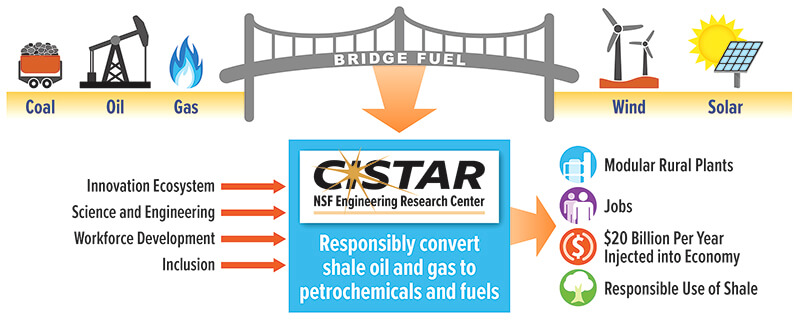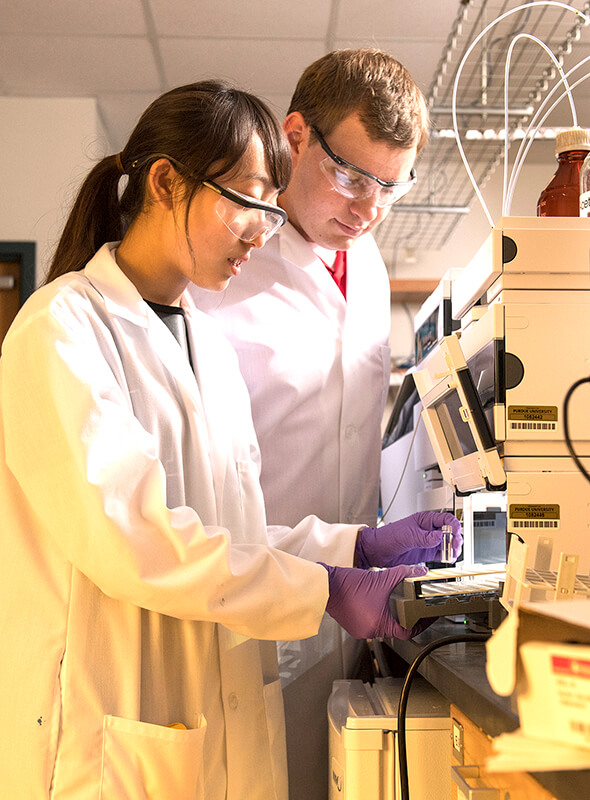September 12, 2017
NSF-funded center at Purdue could help power U.S. for next century
 Purdue University chemical engineering professor Fabio Ribeiro announces the new CISTAR. Purdue President Mitch Daniels and engineering dean Mung Chiang were among those on hand for the announcement in Forney Hall of Chemical Engineering. (Purdue University photo/Rebecca Wilcox)
Download image
Purdue University chemical engineering professor Fabio Ribeiro announces the new CISTAR. Purdue President Mitch Daniels and engineering dean Mung Chiang were among those on hand for the announcement in Forney Hall of Chemical Engineering. (Purdue University photo/Rebecca Wilcox)
Download image
WEST LAFAYETTE, Ind. – The National Science Foundation has chosen Purdue University to lead an engineering research center, which will develop new technologies to produce fuels from U.S. shale-gas deposits that could inject $20 billion annually into the economy.
The new approach proposes to convert light hydrocarbons from shale gas into chemicals and transportation fuels using a network of portable, modular processing plants. It is estimated that there is enough energy in shale to provide all of the nation’s transportation fuels for a hundred years.
Purdue’s Center for Innovative and Strategic Transformation of Alkane Resources, or CISTAR, has received the highly competitive NSF engineering research center designation. It is one of only 19 currently active ERCs in the United States and one of four new ERCs announced this year. The NSF announcement is available at http://bit.ly/NSF_ERC2017. (CISTAR is pronounced See-Star.)
 An abundant U.S. energy resource known as shale gas could be harvested as a “bridge fuel” until renewable technologies can be perfected. CISTAR’s goal is to develop the new technologies needed to convert shale gas into transportation fuels and chemicals. (Purdue University photo)
Download image
An abundant U.S. energy resource known as shale gas could be harvested as a “bridge fuel” until renewable technologies can be perfected. CISTAR’s goal is to develop the new technologies needed to convert shale gas into transportation fuels and chemicals. (Purdue University photo)
Download image
The NSF will provide $19.75 million over five years for the center. Industrial and university partners will contribute additional funding and critical resources.
“This is a prestigious and important moment in the history of Purdue and places our researchers at the center of transformational technological advances in energy production,” Purdue President Mitch Daniels said. “What a tribute to our faculty, whose expertise and dedication enable them to play a leading role in this critical work.”
CISTAR, which officially begins operating on Oct. 1, will be housed in Purdue’s Discovery Park and will be led by Fabio Ribeiro, the R. Norris and Eleanor Shreve Professor of Chemical Engineering.
The center includes academic teams of researchers from Purdue, the University of New Mexico, Northwestern University, the University of Notre Dame and the University of Texas at Austin, as well as partners from industry, national laboratories and national and international research organizations.
“Until we can perfect renewable sources, we have a tremendous resource right here in the United States,” said Sangtae Kim, the Jay and Cynthia Ihlenfeld Head of Purdue’s Davidson School of Chemical Engineering. “We can use domestic shale resources as a bridge until renewable technologies can completely support our society’s needs for chemicals and transportation fuels.”
The team has proposed a new process concept that, with innovations in catalysts, separation processes and reactor designs, is projected to be profitable at today’s energy prices, Ribeiro said.
These new technologies will help the United States maintain its manufacturing competitiveness while reducing the cost and potential environmental risks associated with gas and natural gas liquids transportation by pipeline, trucks and rail. The CISTAR process also will result in lower carbon emissions by reducing the cost of extracting natural gas and improving energy efficiency in converting light hydrocarbons to fuels and chemicals.
“The launch of CISTAR as an engineering research center continues Purdue Engineering’s proud heritage since three decades ago when it led one of the very first ERCs. CISTAR demonstrates how Chemical Engineering at Purdue is transforming our society’s energy future into an efficient and sustainable one.” said Mung Chiang, Purdue’s John A. Edwardson Dean of the College of Engineering. “We are very proud of our faculty’s innovation. We are also confident that the economic benefits to the nation will be substantial as some of the technologies get transferred into commercial impact.”
Information about the center is available at http://cistar.us. A video about CISTAR is available at https://youtu.be/lEZEPE9rdR0.
 Purdue chemical engineering undergraduate student Zige Huang, left, and graduate student Michael Cordon perform research related to work that will be supported by a new NSF engineering research center called CISTAR. (Purdue University photo/John Underwood)
Purdue chemical engineering undergraduate student Zige Huang, left, and graduate student Michael Cordon perform research related to work that will be supported by a new NSF engineering research center called CISTAR. (Purdue University photo/John Underwood)
Download image
“For over 30 years, NSF engineering research centers have promoted innovation, helped to maintain our competitive edge, and added billions of dollars to the U.S. economy,” says NSF Director France A. Córdova. “They bring together talented innovators and entrepreneurs with resources from academia, industry and government to produce engineers and engineering systems that solve real-world problems. I am confident that these new ERCs will strengthen U.S. competitiveness for the next generation and continue our legacy of improving the quality of life for all Americans.”
The CISTAR research will be linked with educational, mentoring and outreach initiatives for students at all levels. Graduate students will have opportunities to engage in multi-institution collaborative research, to mentor undergraduate and K-12 students in research, and to plan and participate in K-12 outreach events. Undergraduate students will learn about the research through coursework and educational training such as an entrepreneurship boot camp.
“CISTAR will lead the development of the next generation of highly educated engineers,” Chiang said. “It will inspire young talents along the STEM pathways to shape our new energy future.”
Suresh Garimella, Purdue’s executive vice president for research and partnerships, said, “CISTAR’s goal to develop new energy technologies that will contribute to the responsible and efficient use of the nation’s immense shale resources is a transformational change in the energy sector as the nation transitions from petroleum and coal to shale gas for energy production. In addition, this technology also presents global benefits and opportunities since shale deposits are found throughout the world.”
Ribeiro said, “We have a team of extraordinarily talented researchers focused on bringing to fruition new ideas that have the potential to convert a huge but still underutilized hydrocarbon resource into a responsible and efficient pathway to a sustainable energy future. We are eager to see the development and commercialization of the ideas, the associated preparation of a diverse and well-educated workforce to enable their applications, and their impact on the energy scene. We are grateful to NSF and our university and industrial partners for making this exciting opportunity possible.”
Media Contact: Emil Venere, 765-494-4709, venere@purdue.edu
Sources: Suresh Garimella, 765-494-6209, sureshg@purdue.edu
Sangtae Kim, 765-494-5692, kim55@purdue.edu
Fabio Ribeiro, 765- 494-7799, fabio@purdue.edu
Note to Journalists: The event will be live streamed at http://www.kaltura.com/index.php/
A YouTube video is available at https://youtu.be/lEZEPE9rdR0. Other multimedia materials are available on Google Drive at http://bit.ly/cistar-gdrive.

